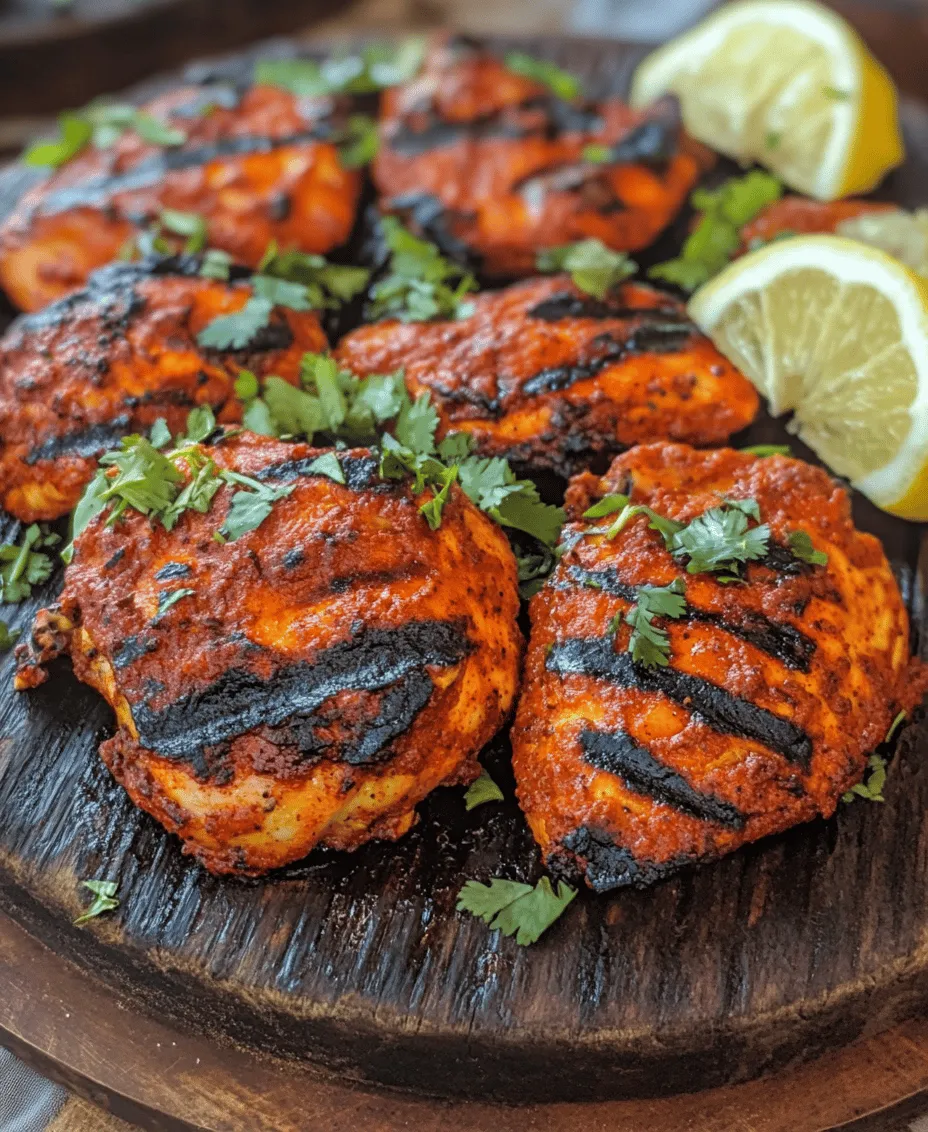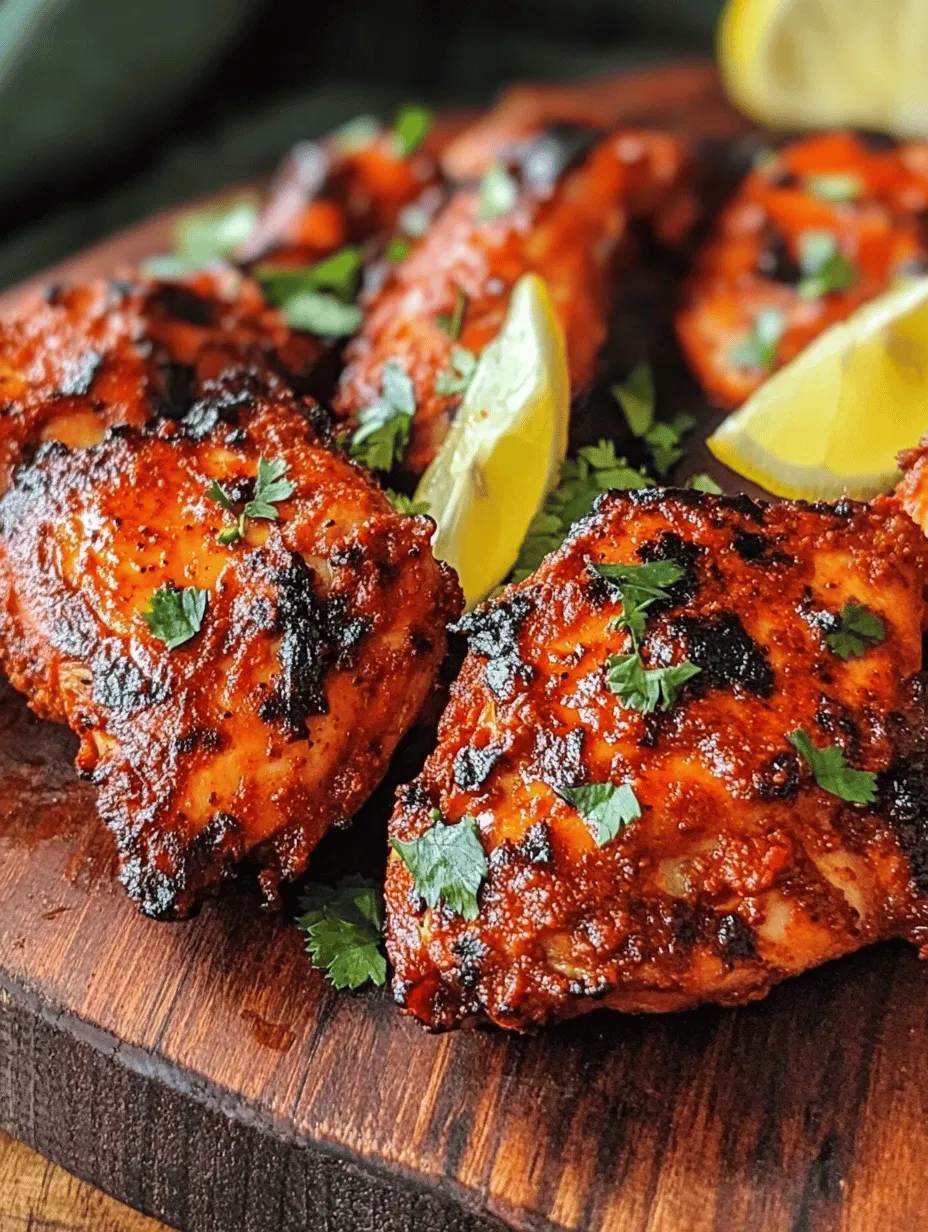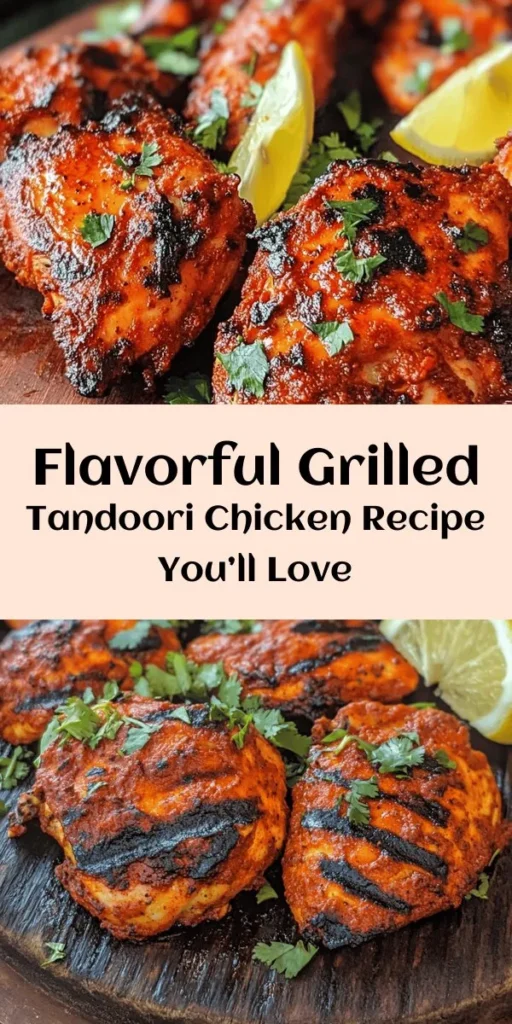Introduction
Tandoori chicken is a beloved dish that holds a special place in Indian cuisine, celebrated for its vibrant colors, aromatic spices, and succulent flavors. Originating from the northern regions of India, this dish has transcended its cultural boundaries to become a global favorite. The traditional preparation involves marinating chicken in a rich blend of spices and yogurt, then cooking it in a tandoor, a cylindrical clay oven that imparts a unique smoky flavor. However, for those who enjoy outdoor cooking, grilling tandoori chicken offers an equally delicious alternative, allowing the same bold flavors to shine through with the added bonus of a charred, crispy exterior.
Grilled tandoori chicken is not only a feast for the senses but also a great dish for gatherings, barbecues, and family dinners. Its appeal lies in the perfect balance of spice and tanginess, a harmony that makes each bite memorable. The use of a tandoor might be traditional, but grilling allows for versatility in preparation and enhances the dish’s accessibility, making it easy for anyone to replicate at home. In this recipe, we will explore the intricacies of preparing grilled tandoori chicken, from understanding its traditional roots to mastering the grilling techniques that bring this dish to life.
Understanding Tandoori Chicken
The Traditional Tandoori Cooking Method
The term ‘tandoori’ refers to the method of cooking in a tandoor oven, a practice that has been a part of Indian culinary traditions for centuries. The tandoor operates on a unique principle; it is heated from the inside using charcoal or wood, creating high temperatures that allow for quick cooking. This method not only cooks the chicken thoroughly but also infuses it with a distinctive smoky flavor that is hard to replicate with other cooking methods. The intense heat helps to lock in the juices, resulting in tender and flavorful meat.
In modern cooking, we can recreate the essence of tandoori chicken by using a grill. The grill’s flames and heat can mimic the cooking style of a tandoor, yielding a similar delicious outcome while offering the convenience of outdoor cooking.
Flavor Profile of Tandoori Chicken
At the heart of tandoori chicken’s appeal lies its complex flavor profile, which is a result of the marinade comprised of yogurt and a variety of spices. The yogurt not only adds a creamy texture but also acts as a tenderizing agent, breaking down the proteins in the chicken and allowing the spices to penetrate deeply. The spices used in tandoori chicken typically include garam masala, cumin, smoked paprika, turmeric, and cayenne pepper. Each spice contributes its unique characteristics, creating a robust and aromatic blend that tantalizes the palate.
– Garam Masala: A blend of spices that adds warmth and depth.
– Cumin: Provides an earthy flavor and enhances the overall aroma.
– Smoked Paprika: Gives a hint of sweetness and a beautiful red color.
– Turmeric: Adds a warm, golden hue and is known for its anti-inflammatory properties.
– Cayenne Pepper: Infuses heat and spiciness to balance the richness of the yogurt.
The marinade is often finished with lemon juice and a drizzle of vegetable oil, which not only enhances the flavor but also helps to keep the chicken moist during cooking. The zesty acidity of the lemon juice brightens the dish while the oil ensures that the chicken doesn’t dry out on the grill.
Health Benefits of Ingredients
The ingredients used in tandoori chicken not only contribute to its flavor but also offer numerous health benefits. Yogurt, a key component of the marinade, is rich in probiotics, which promote gut health. It also provides calcium and protein, making it a nutritious addition. The spices used in the marinade, many of which have been staples in traditional medicine, offer their own health benefits:
– Cumin: Known to aid digestion and boost immunity.
– Turmeric: Contains curcumin, a powerful anti-inflammatory compound.
– Cayenne Pepper: May boost metabolism and improve circulation.
Incorporating grilled tandoori chicken into your diet not only satisfies your taste buds but also provides a wholesome meal packed with nutrients.
Ingredients Breakdown
To create the perfect grilled tandoori chicken, it is essential to gather the right ingredients. Each component plays a critical role in achieving the desired flavor and texture.
Detailed List of Ingredients
– Chicken Thighs: Bone-in versus boneless is an important consideration. Bone-in thighs are juicier and more flavorful due to the bone’s ability to retain moisture during cooking. They are also more forgiving on the grill, as they take longer to cook through, reducing the risk of drying out. However, boneless thighs are easier to handle and cook faster, making them a convenient option for quick meals.
– Yogurt: Full-fat yogurt is preferred for its richness, which helps to create a creamy marinade that clings to the chicken. The acidity in yogurt tenderizes the meat and allows the spices to infuse more effectively.
– Spices:
– Garam Masala: This aromatic blend can be store-bought or homemade for a fresher flavor.
– Cumin: Ground cumin adds a warm, nutty flavor.
– Smoked Paprika: Essential for that smoky depth reminiscent of traditional tandoor cooking.
– Turmeric: Provides vibrant color and health benefits.
– Cayenne Pepper: Adjust the amount according to your heat preference.
– Lemon Juice: Freshly squeezed lemon juice adds brightness and helps to balance the richness of the yogurt.
– Vegetable Oil: A neutral oil like canola or sunflower oil ensures that the flavors of the spices shine while helping to keep the chicken moist.
– Fresh Herbs and Garnishes:
– Cilantro: Fresh cilantro adds a burst of color and freshness when sprinkled on top before serving.
– Lemon Wedges: Serve with wedges for an extra squeeze of citrus just before eating, enhancing the flavor profile.
Preparation Steps
Now that we have an understanding of the ingredients, let’s delve into the preparation steps required to create the flavorful grilled tandoori chicken.
Creating the Marinade
The first step in preparing grilled tandoori chicken is to create the marinade. Start by combining the yogurt with the spices in a large bowl. Use a whisk to blend them thoroughly, ensuring that the spices are evenly distributed throughout the yogurt. This step is crucial, as it allows the flavors to meld together, creating a cohesive marinade that will permeate the chicken.
Next, add the minced garlic and ginger to the mixture. Both ingredients are essential for that aromatic depth synonymous with Indian cooking. The ginger adds a hint of warmth and spiciness, while the garlic brings a savory richness. Finally, mix in the lemon juice and vegetable oil, stirring until you have a smooth and creamy marinade.
Marination Time
Once your marinade is ready, it’s time to prepare the chicken. Pat the chicken thighs dry with paper towels to remove excess moisture. This helps the marinade adhere better, ensuring a more flavorful outcome.
Submerge the chicken thighs in the marinade, making sure each piece is fully coated. Cover the bowl with plastic wrap or transfer the chicken to a resealable plastic bag, ensuring all the air is pressed out. Marinate the chicken in the refrigerator for at least 2 hours, but ideally for 6-12 hours. The longer the chicken marinates, the more flavorful and tender it will become. This extended marination allows the spices to penetrate the meat and the yogurt to work its tenderizing magic.
Safe Handling and Storage
When working with raw chicken, it is important to follow safe handling practices to prevent cross-contamination. Always wash your hands, utensils, and surfaces thoroughly after contact with raw poultry. If you’re not grilling the chicken immediately after marinating, ensure that it is stored in the refrigerator and consumed within 1-2 days. Alternatively, you can freeze marinated chicken for up to 3 months, allowing for a quick meal preparation later on.
Grilling Techniques for Perfect Tandoori Chicken
Once your chicken has marinated to perfection, it’s time to prepare for grilling. Proper grill setup and technique are key to achieving that perfect tandoori flavor.
Pre-Grilling Preparations
Before you start grilling, preheat your grill to a high temperature, around 450°F to 500°F (230°C to 260°C). This high heat is crucial for searing the chicken and creating a nice crust while keeping the inside juicy and tender.
If using a charcoal grill, allow the coals to burn until they are covered with a light ash, which indicates they are ready for cooking. For gas grills, simply turn on the burners to the desired temperature. Once heated, clean the grill grates with a brush to ensure that the chicken does not stick.
While the grill is preheating, remove the chicken from the marinade, allowing any excess marinade to drip off. This prevents flare-ups during grilling and ensures even cooking.
In the next part of this article, we will explore the actual grilling process, including tips for achieving that perfect char, monitoring doneness, and serving suggestions that will elevate your grilled tandoori chicken experience. Stay tuned for the continuation of this flavorful journey into the world of grilled tandoori chicken.

Step-by-Step Grilling Process
Grilling tandoori chicken involves several key steps to ensure that the chicken is flavorful, tender, and perfectly cooked. Begin by preparing your grill, whether it’s charcoal or gas. For charcoal grills, allow the coals to burn until they are covered with ash, indicating they are ready for cooking. For gas grills, preheat to a medium-high setting.
Placement on the Grill: Skin-side Down vs. Flipping Strategies
Once your grill is hot, it’s time to place the chicken on the grill. For optimal results, place the chicken pieces skin-side down. This will allow the skin to crisp up beautifully while locking in moisture. As a general rule, avoid flipping the chicken too often; instead, allow it to sear on one side for about 5-7 minutes before checking for doneness. After the initial sear, flip the chicken and reduce the heat to medium to cook through without burning.
Monitoring Cooking Time for Ideal Doneness
Cooking time can vary based on the size of your chicken pieces. Typically, bone-in chicken thighs and drumsticks will take about 25-30 minutes to cook through, while chicken breasts may take 20-25 minutes. It’s essential to keep an eye on the chicken, rotating the pieces every 5-7 minutes to ensure even cooking. This method allows for a beautifully charred exterior while keeping the inside juicy.
Using a Meat Thermometer for Safety and Perfect Results
To ensure your chicken is safely cooked, use a meat thermometer. The internal temperature of the chicken should reach 165°F (75°C) in the thickest part of the meat, avoiding any contact with the bone. If the chicken is not yet at the right temperature, continue grilling and check again after a few minutes. This tool is invaluable for ensuring that your grilled tandoori chicken is both safe to eat and perfectly tender.
Post-Grilling Tips
Once your tandoori chicken is grilled to perfection, it’s essential to understand the next steps to enhance its flavor and presentation.
Importance of Resting the Chicken
After grilling, allow the chicken to rest for at least 5-10 minutes before serving. Resting is crucial as it lets the juices redistribute throughout the meat, resulting in a juicier and more flavorful bite. Cutting into the chicken too soon can cause the juices to run out, leading to a dry texture.
Suggestions for Serving
Grilled tandoori chicken pairs beautifully with various accompaniments. Traditional sides include:
– Naan: Soft, fluffy naan bread complements the spices of the chicken and is perfect for scooping.
– Rice: Serve it over a bed of fragrant basmati rice, optionally sprinkled with fresh cilantro for an aromatic touch.
– Cucumber Raita: This cooling yogurt-based condiment helps balance the spices and offers a refreshing contrast.
Presentation Ideas for Serving Grilled Tandoori Chicken Attractively
Presentation can elevate your dining experience. Arrange the grilled chicken on a large platter, garnished with fresh cilantro, lemon wedges, and slices of red onion. A vibrant salad made from cucumber and tomatoes can add color and freshness to the plate. Consider serving in individual portions for a more refined look.
Nutritional Information
Understanding the nutritional content of your grilled tandoori chicken can help you maintain a balanced diet while enjoying flavorful meals.
Breakdown of Nutritional Values Per Serving
– Calories: Approximately 250-300 calories per serving (varies based on portions and cuts).
– Protein: About 30 grams, making it a great source of lean protein.
– Fat: Roughly 10-15 grams, depending on whether you remove the skin.
– Carbohydrates: Minimal, around 2-5 grams, primarily from spices and yogurt.
Discussion on the Health Benefits of the Main Ingredients
The primary ingredients in tandoori chicken—yogurt and spices—offer significant health benefits:
– Yogurt: Rich in probiotics, it promotes gut health and adds a creamy texture to the marinade.
– Spices: Ingredients like turmeric, cumin, and coriander have anti-inflammatory properties and are rich in antioxidants, contributing to overall health.
Variations and Customizations
One of the best aspects of the tandoori chicken recipe is its versatility. Here are some ideas for variations and customizations.
Vegetarian Alternative Using Paneer or Tofu
For a vegetarian twist, substitute chicken with paneer or firm tofu. Marinate the paneer or tofu in the same tandoori marinade, adjusting the marinating time to about 30 minutes since these ingredients absorb flavors quickly. Grill until golden brown for a delicious vegetarian option.
Adjusting Spice Levels for Different Palates
The spice levels in tandoori chicken can easily be adjusted to suit different taste preferences. For a milder flavor, reduce the amount of cayenne pepper or omit it entirely. Conversely, if you enjoy a spicy kick, you can add extra chili powder or include fresh green chilies in the marinade.
Ideas for Marinating Other Meats or Seafood with the Same Spices
The tandoori marinade is not just limited to chicken. Other meats like lamb or fish can be marinated using the same spices. For seafood, a shorter marination time of about 15-30 minutes is recommended to prevent the proteins from breaking down too much.
Cultural Context and Popularity
Tandoori cooking has a rich history rooted in Indian cuisine. Traditionally, tandoori dishes are cooked in a clay oven known as a tandoor, which imparts a unique smoky flavor to the food. The cooking technique dates back to ancient times, where it was used for baking bread and roasting meats.
Brief History of Tandoori Cooking and Its Cultural Significance in India
Tandoori cooking is deeply cultural, often associated with festive occasions and communal gatherings. The rich history is tied to the nomadic tribes of North India, who used tandoors for cooking during their travels. Over the years, it has evolved and become a staple in Indian restaurants worldwide.
The Global Popularity of Tandoori Chicken and Its Adaptations in Various Cuisines
Today, tandoori chicken has transcended borders, gaining immense popularity in various countries. It has been adapted in numerous ways, from fusion dishes to fast food varieties, while still retaining its essence. In Western cuisine, tandoori chicken can often be found in wraps, salads, and even pizzas, showcasing its versatility.
Conclusion
Homemade grilled tandoori chicken is not just a meal; it’s an experience bursting with flavor and cultural significance. The process of marinating, grilling, and serving this dish creates an opportunity to explore the rich culinary traditions of India while enjoying a delightful meal with family and friends.
We encourage you to try this recipe and experience the deliciousness of grilled tandoori chicken in your own kitchen. Whether you’re hosting a barbecue, a family dinner, or simply craving something flavorful, this dish is sure to impress. Embrace the joy of grilling and share this delightful dish with your loved ones, creating memories that last a lifetime.



